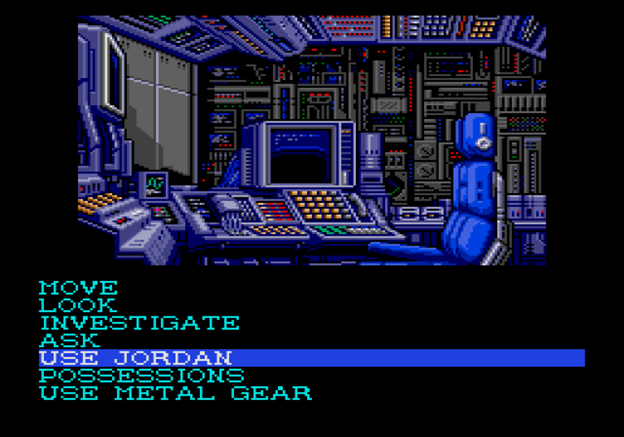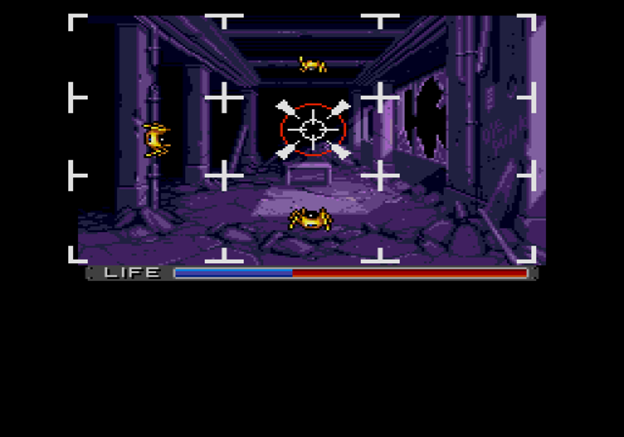Trending
Opinion: How will Project 2025 impact game developers?
The Heritage Foundation's manifesto for the possible next administration could do great harm to many, including large portions of the game development community.

Featured Blog | This community-written post highlights the best of what the game industry has to offer. Read more like it on the Game Developer Blogs or learn how to Submit Your Own Blog Post
Snatcher is usually regarded as a cult-classic that lays the foundation for Kojima's later work. It is more than that, however.
February 5, 2024

Students in my game design classes often see me in a sharp looking t-shirt with the Snatcher logo. I'll fully admit that I loved this logo and shirt design long before I actually played through the entire game, which I have only done recently, in January 2024.
I had started it a few times, not progressing much past the opening sequence in the factory. The reason is simple: this is a hard game to acquire. The only version in English is the SegaCD version, which is a minimum of eight hundred dollars on eBay. The only saving grace is that you don't really need original hardware: SegaCD games will work as-is with an emulator, so if your PC has a DVD drive, you can simply play the games.
Of course, this also means that the game is exceedingly easy to, er, well, pirate. In my case, I'm more-or-less borrowing a friend's legitimate copy. Sort of. It's complicated (Konami, if you are listening, please do a proper re-release of the game, it is beloved and would certainly make so much sense as a Switch eShop release: I'd buy it just to have it).
Regardless, the next problem with Snatcher is that the emulation isn't perfect. The commonly available rips that one might find if they search the dark corners of the internet don't actually work well (no sound typically). You really do need to do an iso rip yourself of someone's legitimate copy. But even then, the emulator tends to hang for minutes at a time, making the experience imperfect.
However, after completing Hotel Dusk and its sequel Last Window, I really wanted to finally play through Snatcher. So, I put up with the random moments where game flow would get broken by the emulation hanging and played through it.
I thoroughly enjoyed the game. Confirmation bias alert: I love Hideo Kojima's work and I am predisposed to like games like this, that have a heavy emphasis on gestalt, terrific soundtracks, and great style. Snatcher has all of these things.
What it also has, however, is surprisingly effective detective gameplay. Some of the best I've played, actually. What's the key?
It's so incredibly simple and boring!
What? Boring? Why yes! But boring in a good way.

One of the most interesting challenges in game design is trying to represent inductive reasoning as gameplay mechanics. That brilliant leap of logic displayed by Hercule Poirot, Lieutenant Columbo, or Sherlock Holmes. The challenge lies in that the player doesn't have those mental superpowers, so you have to kind of trick the player into thinking they have them through clever mechanics.
This typically manifests in abstract gameplay such as LA Noire's attempt to use facial expressions or Phoenix Wright's use of evidence inventories being juxtaposed against witness testimony. I don't wish to examine deeply how well these mechanics work, other than to say that some do, and some do not.
Instead, I'd like to point out the Snatcher does... none of those things. It doesn't even try. It's version of detective work is not only simpler but might actually be more like the real thing.
How Snatcher Gamifies the Investigative Process:
Gillian Seed, the protagonist, is not portrayed as anything but a normal guy, at least until the end of the game. Even then, whatever skills and knowledge he may have had were largely erased by his amnesia (this game was developed in the 1980s, amnesia wasn't a completely overused trope then!).
As such, Seed's investigations do not involve clever badgering of a witness, astounding feats of logic, or asking someone "just one more thing." Nope, Gillian just works hard. He grinds.
The game represents this by giving you a simple and consistent set of commands for each game screen:
Look
Examine
Ask (if a person is present)
Possessions (your inventory)
Use Metal Gear (your robot assistant, and yes, this game does take place in the Metal Gear universe, though there are unexplained continuity issues with that).
Each command then has a submenu. For Look, you get a list of things to look at.
Generally, the game flow of a standard Snatcher screen might look like this:
Look -> Look at Object, which may reveal something to examine. Examine -> More closely inspect various room objects, including things revealed with the look command.
If the room has no persons present, you just repeat this process over and over until everything has been looked at, revealing all the things that can be examined, which may or may not put additional items in your possessions.
And that's the game, largely. Go into a room and do absolutely everything the game says you can do in it. There really isn't a ton of thought here, other than making sure you've done everything. Sometimes the game logic dictates that you actually have to go through everything before new things are revealed, and sometimes the same things have to be selected more than once. But by and large, just do all the things available, and you'll advance the game.
I find myself enjoying this far more than I should if I simply read about this in a design document. The reason? Representation. According to Chris Crawford in The Art of Computer Game Design, this is the fantasy the player brings into the game. Here, the fantasy is "cyberpunk detective." What do detectives actually do? A lot of mundane stuff. They collect information. They have to be thorough. They have to go over the same materials again and again to make sure nothing is missed.
In other words, Snatcher's simple structure quite accurately supports the detective fantasy. It feels authentic.

There are various set-pieces throughout the game, however, which do help allay any monotony that may occur as a result of the core gameplay loop. These are:
Shooting sequences (that supported Sega's light gun peripheral but are perfectly playable on a gamepad). These are pretty simple but surprisingly intense. I'll admit that in the end-game sequence, it is probably a design flaw that you are made to restart multiple scenarios in a row if you get a game over (a problem that you won't experience using an emulator's save states, naturally).
Light-puzzle solving set-pieces. There are a variety of these, some being as simple as telling your robot partner, Metal Gear (yes, it is that Metal Gear, just small and without the nuclear weapons), to analyze something. Others have more complexity, with my favorite being the face compositing mini game, which is very clever.
Narrative set-pieces that take the game's standard investigative structure and utilize it in a clever way. A great moment occurs when Gillian's turbo cycle has a malfunction, and you must frantically select through a variation of the game's standard commands.
These set pieces are nicely distributed throughout the game's roughly six-to-eight-hour runtime.
Finally, it should be stated that Snatcher's narrative pacing is superb. The game never makes the player wait too long to get a significant plot beat delivered. This is crucial in a game like this, which does not have action-oriented gameplay.
Hideo Kojima does not seem particularly interested in stumping the player either, which can be typical of story-based games from this era. Generally speaking, Metal Gear or someone else will give a hint when you meander too long.
Snatcher is an excellent demonstration that basic interactions are by themselves pleasurable, and a good game design needn't go to extremes in complexity to give the player the desired fantasy.
A fairly large game world is represented mostly by static still images with limited animation. Perhaps a modern open-world game could be fulfilled with modern rendering technologies but using a similar approach to greatly truncate the development effort required to make the game world.
An example of narrative being delivered using limited visual scope can be found in a modern Kojima work, Death Stranding. While offering a vast outdoor landscape, much of the game's narrative is delivered via stationary holograms with limited animations.
Finally, it is important to note that Snatcher seems designed around a particular verb, that is to investigate. Investigation is simply gathering information, so that is how the game is structured. Considering Kojima's other work, we may see this same emphasis on designing around a core action: Metal Gear Solid's sneak and Death Stranding's deliver.
These verbs are not the usual game design verbs such as shoot, punch, or jump, though you do plenty of those things in Kojima's games. The lesson here is, then, that by making a game design pillar something unrelated to a typical gaming action verb, you arrive at a completely different flavor of game even if the game contains similar components to others.
Snatcher is usually regarded as a cult-classic that lays the foundation for Kojima's later work. It is more than that, however. It has its own distinct game design ideas that are worthy of consideration, particularly for its effective representation of detective gameplay and efficient narrative and world design. In any event, it is a work that should be played by serious students of game design, so here's hoping that Konami makes this classic more easily available in the future.
Read more about:
Featured BlogsYou May Also Like